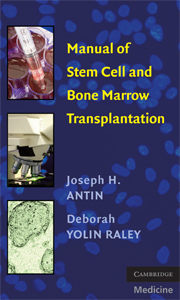Book contents
- Frontmatter
- Contents
- Acknowledgments
- Manual of Stem Cell and Bone Marrow Transplantation
- 1 Rationale for Transplantation
- 2 Types of Transplantation
- 3 HLA Matching in Allogeneic Transplantation
- 4 Stem Cell Source
- 5 Pretransplant Evaluation and Counseling of Patient and Donor
- 6 Conditioning Regimens
- 7 Stem Cell Infusion
- 8 ABO Compatibility
- 9 Engraftment
- 10 Preventative Care
- 11 Transplant-Related Complications
- 12 Graft-Versus-Host Disease – Prophylaxis and Acute
- 13 Graft-Versus-Host Disease – Chronic
- 14 Engraftment Syndrome
- 15 Infectious Disease
- 16 Graft Rejection And Failure
- 17 Gastrointestinal Complications
- 18 Pulmonary Complications
- 19 Veno-Occlusive Disease
- 20 Special Transfusion-Related Situations
- 21 Cardiovascular Complications
- 22 Neurologic Complications
- 23 Cystitis
- 24 Donor Lymphocyte Infusion
- 25 Transplantation: Regulation And Accreditation
- Appendix
- Index
23 - Cystitis
Published online by Cambridge University Press: 23 November 2009
- Frontmatter
- Contents
- Acknowledgments
- Manual of Stem Cell and Bone Marrow Transplantation
- 1 Rationale for Transplantation
- 2 Types of Transplantation
- 3 HLA Matching in Allogeneic Transplantation
- 4 Stem Cell Source
- 5 Pretransplant Evaluation and Counseling of Patient and Donor
- 6 Conditioning Regimens
- 7 Stem Cell Infusion
- 8 ABO Compatibility
- 9 Engraftment
- 10 Preventative Care
- 11 Transplant-Related Complications
- 12 Graft-Versus-Host Disease – Prophylaxis and Acute
- 13 Graft-Versus-Host Disease – Chronic
- 14 Engraftment Syndrome
- 15 Infectious Disease
- 16 Graft Rejection And Failure
- 17 Gastrointestinal Complications
- 18 Pulmonary Complications
- 19 Veno-Occlusive Disease
- 20 Special Transfusion-Related Situations
- 21 Cardiovascular Complications
- 22 Neurologic Complications
- 23 Cystitis
- 24 Donor Lymphocyte Infusion
- 25 Transplantation: Regulation And Accreditation
- Appendix
- Index
Summary
There are two main causes of hemorrhagic cystitis in the transplant patient: conditioning regimen-related toxicity and viral infection. Cystitis that occurs early (day 1 to 14) is usually caused by the conditioning agents, and is usually related to highdose cyclophosphamide. The incidence of early cystitis reduced with the use of aggressive hydration with forced saline diuresis or the use of Mesna for uroprotection. Mesna binds to an inactive metabolite of cyclophosphamide, acrolein, preventing urothelial inflammation. Mesna is effective only during cyclophosphamide metabolism/excretion and not once hemorrhagic cystitis is established. We recommend prehydration with 1,000 cc of D5NS with 20 mEq/L of KCl at 500 cc/hr for at least 2 hours precyclophosphamide dose and maintenance of hydration with D5½NS at 200 cc/hr for 12 hours after cyclophosphamide using furosemide if necessary to keep urine output >200 cc/hr.
Hemorrhagic cystitis that occurs after day 14 is usually due to a viral infection. The two most common infections include BK virus and Adenovirus infection.
DIAGNOSIS
Urine should be sent for urinalysis, bacterial and viral culture, and BK and Adenovirus polymerase chain reaction (PCR). If adenovirus infection is confirmed it is important to monitor for systemic disease and treat if it disseminates.
TREATMENT
There is no defined treatment for BK-associated cystitis and no treatment can be recommended at this time.
- Type
- Chapter
- Information
- Manual of Stem Cell and Bone Marrow Transplantation , pp. 155 - 156Publisher: Cambridge University PressPrint publication year: 2009



